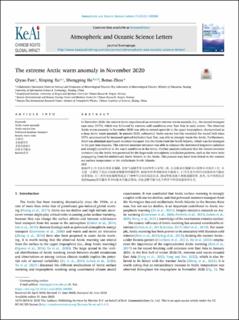The extreme Arctic warm anomaly in November 2020
Journal article, Peer reviewed
Published version

Åpne
Permanent lenke
https://hdl.handle.net/11250/3044707Utgivelsesdato
2022Metadata
Vis full innførselSamlinger
- Geophysical Institute [1223]
- Registrations from Cristin [10237]
Originalversjon
Atmospheric and Oceanic Science Letters. 2022, 15 (5), 100260. 10.1016/j.aosl.2022.100260Sammendrag
In November 2020, the eastern Arctic experienced an extensive extreme warm anomaly (i.e., the second strongest case since 1979), which was followed by extreme cold conditions over East Asia in early winter. The observed Arctic warm anomaly in November 2020 was able to extend upwards to the upper troposphere, characterized as a deep Arctic warm anomaly. In autumn 2020, substantial Arctic sea-ice loss that exceeded the record held since 1979, accompanied by increased upward turbulent heat flux, was able to strongly warm the Arctic. Furthermore, there was abundant northward moisture transport into the Arctic from the North Atlantic, which was the strongest in the past four decades. This extreme moisture intrusion was able to enhance the downward longwave radiation and strongly contribute to the warm conditions in the Arctic. Further analysis indicated that the remote moisture intrusion into the Arctic was promoted by the large-scale atmospheric circulation patterns, such as the wave train propagating from the midlatitude North Atlantic to the Arctic. This process may have been linked to the warmer sea surface temperature in the midlatitude North Atlantic.
